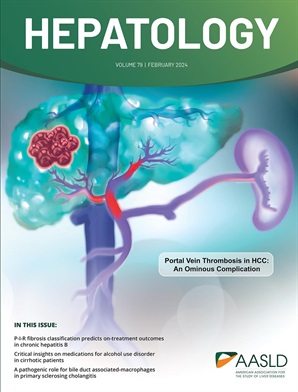Social determinants of health influence the risk of cirrhosis: A diverse nationwide cohort study
IF 12.9
1区 医学
Q1 GASTROENTEROLOGY & HEPATOLOGY
引用次数: 0
Abstract
Background and Aims: Cirrhosis is a leading cause of mortality in the United States, with significant disparities influenced by social determinants of health (SDOH). This study evaluated the effects of SDOH on the risk of cirrhosis in a nationwide cohort of patients. Approach and Results: We conducted a retrospective cross-sectional cohort study from the All of Us Research Program (AOURP) enrolled 2017-2022. The primary outcome was cirrhosis, defined using International Classification of Disease codes. The primary predictors were SDOH factors measured by validated questionnaires and scaled to a 1-5 score or dichotomized. 83,061 adults with SDOH assessments were included in the final cohort, of whom 1,008 had cirrhosis. Neighborhood-level factors of social disorder (per-point OR 1.36, 95% CI 1.21-1.54,健康的社会决定因素影响肝硬化的风险:一项多样化的全国队列研究
背景和目的:肝硬化是美国死亡的主要原因,受健康社会决定因素(SDOH)的影响,存在显著差异。本研究评估了SDOH对全国队列患者肝硬化风险的影响。方法和结果:我们进行了一项回顾性横断面队列研究,来自2017-2022年入组的“我们所有人”研究计划(AOURP)。主要终点是肝硬化,根据国际疾病分类代码定义。主要预测因素是SDOH因素,通过有效的问卷测量,并按1-5分或二分类。最终队列纳入83061名SDOH评估的成年人,其中1008人患有肝硬化。社区水平的社会紊乱因素(per-point OR 1.36, 95% CI 1.21-1.54, 0.001)和犯罪因素(per-point OR 1.17, 95% CI 1.10-1.24, 0.001)与肝硬化风险增加有关。社区和个人水平的食品不安全因素(OR 2.00, 95% CI 1.71-2.32, 0.001)和日常歧视因素(per point OR 1.19, 95% CI 1.09-1.30, 0.001)同样与较高的风险相关。相反,社会凝聚力(per point OR 0.83, 95% CI 0.76-0.90, p=0.001)、英语熟练程度(OR 0.64, 95% CI 0.49-0.84, p=0.001)和社会支持(per point OR 0.82, 95% CI 0.78-0.87, p=0.001)与肝硬化风险降低相关。大多数SDOH的人口归因分数在0.10 ~ 0.15之间。结论:在全国不同人群中,SDOH因素与肝硬化风险密切相关,并解释了肝硬化风险的高比例变异性。SDOH应被视为晚期肝病的关键可改变危险因素。
本文章由计算机程序翻译,如有差异,请以英文原文为准。
求助全文
约1分钟内获得全文
求助全文
来源期刊

Hepatology
医学-胃肠肝病学
CiteScore
27.50
自引率
3.70%
发文量
609
审稿时长
1 months
期刊介绍:
HEPATOLOGY is recognized as the leading publication in the field of liver disease. It features original, peer-reviewed articles covering various aspects of liver structure, function, and disease. The journal's distinguished Editorial Board carefully selects the best articles each month, focusing on topics including immunology, chronic hepatitis, viral hepatitis, cirrhosis, genetic and metabolic liver diseases, liver cancer, and drug metabolism.
 求助内容:
求助内容: 应助结果提醒方式:
应助结果提醒方式:


